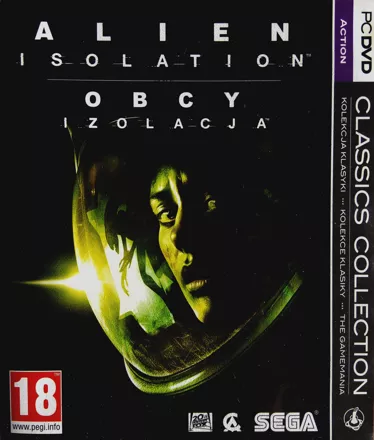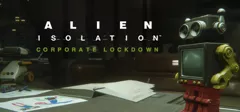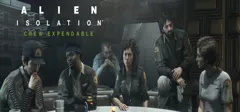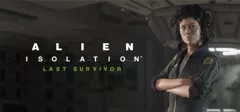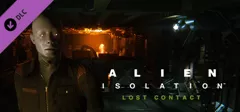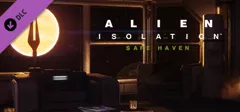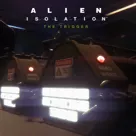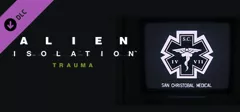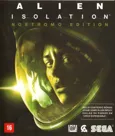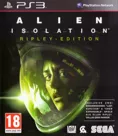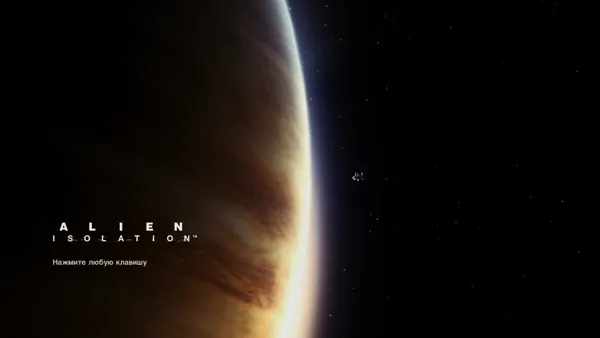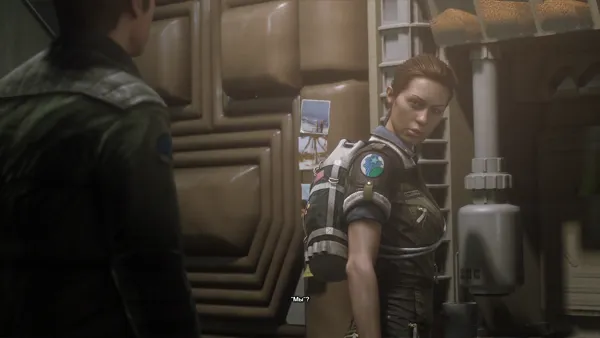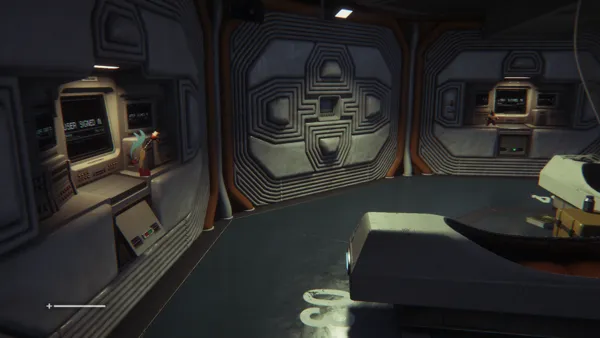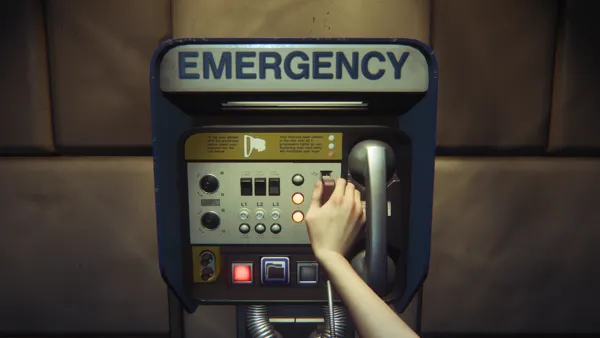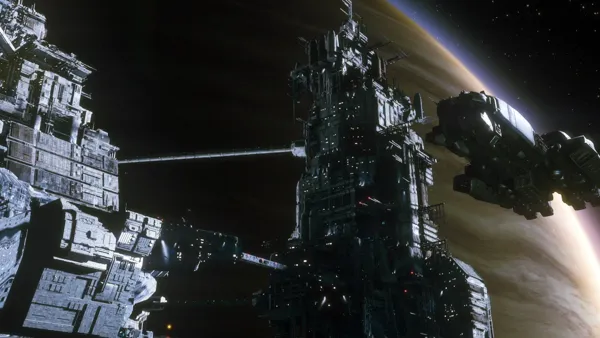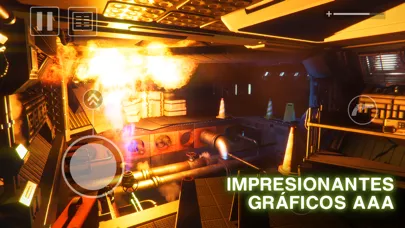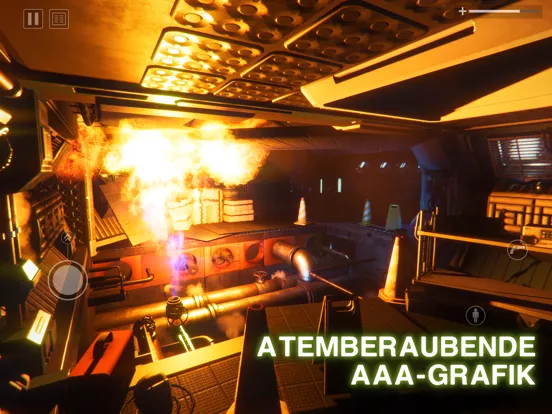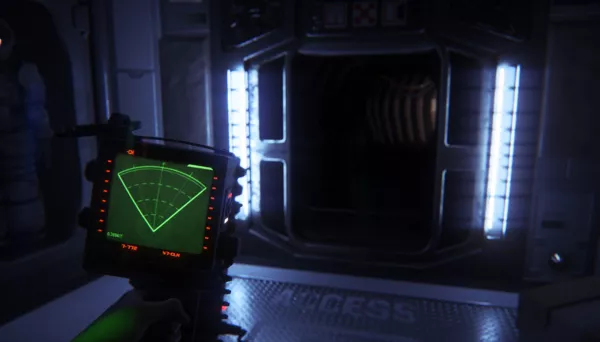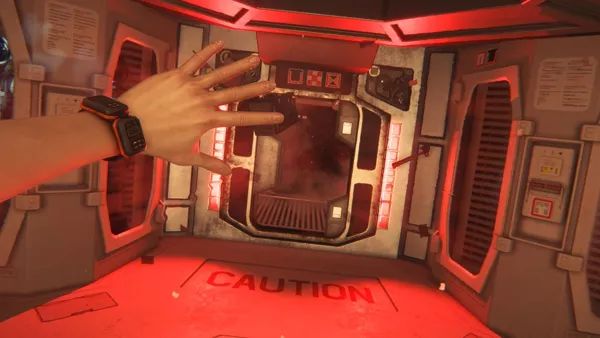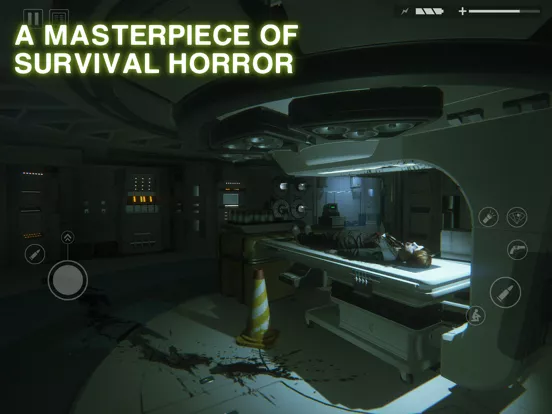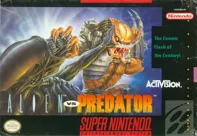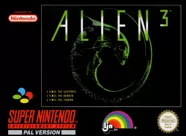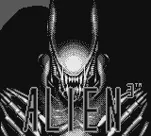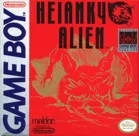Alien: Isolation
Description official descriptions
Fifteen years after the events of Ridley Scott's Alien Ellen Ripley's daughter Amanda is looking for answers. She is an engineer working for Weiland-Yutani Corporation. When she finds out that the logs from USCSS Nostromo have been located and transported to Sevastopol space station she decides to join a small crew sent by Weiland-Yutani to retrieve the data. Little does she know that the ship that has found the logs reached Sevastopol with a terrifying passenger on board, the one that murdered the majority of station's population and left the survivors cowering in fear.
Alien: Isolation is a survival horror game. It is set on the Sevastopol space station where Amanda is searching for USCSS Nostromo logs. Sevastopol is split into many areas, and a certain degree of freedom is given to the player: areas may have several alternative routes to the goal, hidden rooms and ventilation shafts; also Amanda may (and later needs to) backtrack through the station. As the game goes on Amanda's tools will be upgraded and she will be able to get access to previously out of reach areas.
Amanda is an engineer, so she is able to loot containers and bodies for resources and craft devices like noisemakers, smoke bombs, or Molotov cocktails, mainly used to distract the enemy. Later she acquires a flashlight, a motion detector and several types of weapons to defend herself against humanoid enemies (groups of hostile survivors or androids). However, Amanda is not a fighter, and each encounter should be carefully planned. Many actions take some time, for example to use a medpack Amanda needs to stand perfectly still.
When Amanda draws attention of the alien, stealth is the only way to survive. The alien cannot be harmed, and it kills Amanda in a single hit. In most cases it doesn't follow a predetermined scripted route, but instead relies on its senses to track Amanda down.
In addition to the main story mode there's Survivor mode in which the player needs to escape from a specially designed map fulfilling secondary objectives along the way, while being aggressively hunted by the alien. This mode includes online leaderboards.
Spellings
- エイリアン アイソレーション - Japanese spelling
- 异形:隔离 - Simplified Chinese spelling
Groups +
Screenshots
Promos
Videos
See any errors or missing info for this game?
You can submit a correction, contribute trivia, add to a game group, add a related site or alternate title.
Credits (Windows version)
572 People (543 developers, 29 thanks) · View all
| Dedicated to the Memory of our Friend and Colleague |
|
| Creative Lead | |
| Senior Producer | |
| Lead Programmer | |
| Lead Artist | |
| Lead Designers | |
| Lead Level Design | |
| Lead Environment Artists | |
| Lead Technical Artist | |
| Lead VFX Artist | |
| Lead Lighting Artist | |
| Lead UI Artist | |
| Lead Character Artist | |
| Lead Animator | |
| Lead Engine Programmer | |
| Lead AI Programmer | |
| Lead Core Tech Programmer | |
| Lead Tools Programmer | |
| Lead Audio Designer | |
| Producer |
|
| Associate Producers | |
| Design | |
| [ full credits ] | |
Reviews
Critics
Average score: 83% (based on 56 ratings)
Players
Average score: 4.1 out of 5 (based on 66 ratings with 2 reviews)
The Good
Note: Mild spoilers follow
I’ll begin with a riddle: How many videogame developers does it take to create a decent, Alien franchise-inspired video game?
The answer? Too damned many.
Believe it or not, this is the 38th officially-licensed instalment in the long line of games inspired to some extent by either Ridley Scott’s eponymous Alien from 1979 or James Cameron’s 1986 sequel, Aliens (if you include all of the Alien vs. Predator titles as well).
Like the acidic blood of the Xenomorphs themselves, almost every developer who chooses to venture into this franchise gets inevitably burnt. The overwhelming majority of Alien-derived games have been utterly worthless, with the exception of Rebellion’s 1994, Alien Vs Predator on the Jaguar, their subsequent Aliens Versus Predator for the PC (1999) and Monolith’s follow-up to that, Aliens Versus Predator 2 (2001). Understandably so, gamers have treated any announcement of yet-another Alien franchise-based title with cautious scepticism, particularly when Sega is concerned, given their disastrous involvement in the Alien Vs Predator reboot from 2010 and the universally-panned, Aliens: Colonial Marines of 2013.
When the gaming world got wind of Alien: Isolation, the general knee-jerk reaction was lukewarm to hostile. It was akin to asking a grieving widow, days after the funeral, to suddenly start hitting swinger’s parties. The fallout from the train wreck that was ACM hadn't even settled and Sega was already marketing another Alien-themed IP so soon after. It seems that either Sega has something of a conscience and couldn’t let the stench of AVP and ACM taint them any longer or that 20th Century Fox, Ridley Scott, James Cameron and H.R. Giger were all threatening to press defamation charges against the next video game developer who dared to blaspheme their intellectual property.
In another surprising development, The Creative Assembly, yes the Total War folks, were slated to be developing this instalment. No disrespect to The Creative Assembly as they can certainly make a fine game, but their bread and butter is RTS, not Survival Horror. News that the game would forego the historical tendency to make an action-oriented FPS based on the second film, and instead focus on a predominantly one-on-one, cat-and-mouse game of survival horror with a lone Xenomorph, almost like Amnesia: The Dark Descent, was also a cause for concern.
So we’ve got the wrong developer making the wrong game, with the wrong publisher, at the wrong time, when consumer receptiveness couldn’t be lower, using a rather experimental approach to the canon that no one has ever tried before?
How on Earth then, does this game kick so much ass?
Changing the worn-out formula was definitely what the doctor ordered for future Alien franchise-based games. The action-heavy, chaotic slug fests with the cheesy, hackneyed Colonial Marines had been seriously overdone in the past and more to the point, they totally killed whatever horror potential the Xenomorphs had. Though I vividly recall being spooked a handful of times playing as the Marine in Alien Vs Predator 2, the fire fights in AVP 2 only escalated in frequency & intensity, where they should have been interspersed with intervals of suspense. After the 10th or 20th encounter with a room full of Xenomorphs, you didn’t see the nightmarish enemy as anything other than just another target for your incredibly rapid-firing Smart Gun.
Alien: Isolation is all about evoking the first film’s sense of Ripley and the USCSS Nostromo’s crew being way out of their depth.
The story of the game occupies the timeline gap between the first two films, taking place 15 years after the events of the first film, while Ellen Ripley is still drifting aimlessly in space aboard the Nostromo’s escape shuttle, but long before the Colonial Marines revisit LV426 in the second film. TCA eschewed previous attempts at spinning-off into completely new story-arcs and locations with little basis in the canon, instead making a concerted attempt to stay within the realms of existing fiction; a refreshingly humble approach that unburdens the developers from the difficulty of living up to the original script-writing and allows for more emphasis on the gameplay. Ripley’s daughter, Amanda (who’s briefly mentioned in Aliens), is given a chance to find closure over the disappearance of her mother along with the entire star-freighter she was assigned to. An ad-hoc team is assembled and sent via the starship Torrens, to go and fetch the Nostromo’s flight recorder from Sevastopol Station, a commercial trading hub orbiting a gas giant in the Zeta Reticuli system, 39 light years from Earth. As is tradition in the Alien films, everything goes very wrong, very quickly. Amanda finds herself cut-off from the Torrens and her crew, facing no choice but to board Sevastopol station alone. Like mother, like daughter, Amanda Ripley quickly finds herself to be the only person on the station with enough perseverance to bring about some measure of salvation, after most of the other NPCs are picked off, one-by-one.
Your first baby-steps on Sevastopol station reveal a crippled and battle-scarred spaceport, littered with ominous warnings, along the lines of the opening levels of System Shock 2 or BioShock. Reading scattered logs and journals to learn that the decommissioning of the station and the huge reduction of its crew took place months before your arrival don’t bode well for your nerve, and the few living survivors you encounter are about as hospitable as the Xenomorph itself is. The iconic Weyland-Yutani, despite having a brief role in the game, is supplanted by the rival space colonisation firm, Seegson Corporation, as the unethical and dishonest megacorporation looking to maximise their bottom line at everyone else’s expense. Like the film series, corporate greed is once again a central theme in Alien: Isolation and, without saying too much, is revealed to be the primary reason for the Xenomorph’s “birth” aboard Sevastopol.
Gameplay-wise, what we have here is top-notch pacing that makes virtually no use of canned jump scares, combined with a jaw-dropping sound design that delivers incredibly accurate positional audio, and excellent creature A.I. that when combined together, delivers a very satisfying game of hide-and-seek. Only that it happens to be on a space station, with homicidal androids, paranoid humans, a crumbling, hazardous structure and more back-stabbers than the Roman Senate during the Ides of March.
The tension created by you having to frantically spin around as you follow the Xenomorph on your motion tracker, while it barrels through ventilation shafts you can’t see and corridors that you have to remember the layout of (so as to know if that innocuous green dot on your tracker could actually be on top of you at any second), as you simultaneously scan your local surroundings for a suitable hiding spot, is so thick you could cut it with a meat cleaver. The motion tracker’s blinking, beeping green dot becomes more terrifying than the Xenomorph itself in many respects, serving as a piercing reminder of your character’s vulnerability and of how many seconds you are from death at all times.
The first time you’re dragged out of the air vent you desperately crawled into for safety, or when the closet door that separates you and certain death is ripped open, is unbelievably heart-pounding. Amanda Ripley’s heartfelt screams as the trade-mark, double-jawed menace looms inches away from her face, about to deliver the coup de grâce, really make death feel like a poignant defeat.
This game delivered more out-of-my-seat shocks than almost every other Survival Horror game of recent memory. The worst came from those frequent moments of playing chicken, when the Xenomorph paced determinately along the path to your objective, forcing you to either: make a run for it, temporarily distract/scare it away or take a longer detour. Many a time you would be forced to detour from the shortest route not because you laid eyes on that trademark elongated head, but simply due to the unmistakable noises from the ceiling reminding you that death was waiting to pounce on you from the next overhead duct or the tell-tale acidic ooze dripping from vents.
In white-knuckle moments like these, underestimating the creature’s movement speed or its sudden changes of direction, delivered some startlingly frantic sprints for survival. Leaping out from under a table to make a run for a nearby door only to hear the creature acknowledge your presence with a growl and then watching as it closed the distance on your motion tracker were legitimately unnerving. Even minor taps of a movement key while hidden under a table with the Xenomorph stalking inches away, was enough to trigger a vicious and swift pounce; made all the more jarring by the wickedly slick, life-like animations of the creature. The way its tail tossed debris aside as it clambered down hallways were nice touches that reinforced the distinct impression of you being the prey in this game. The dynamic soundtrack increases the pounding drum beat and shrill violins to a fervent tempo as the Xenomorph nears to you, building you up for either a massive sigh of relief as it turns its back to you and skulks away, or yet another gruesome death scene.
Even hunting around for supplies during a seeming “lull” in the Xenomorph’s predatory stalking has to be done fast; hang around the same location too long and you risk trapping yourself in an inopportune area of the map with no alternate exit.
I found myself checking the in-game map furiously, pre-planning my contingency exit before I set foot into each room, roughly trying to calculate how much time I had to search for a keycard while making sure that I was in close proximity to a known hiding spot like a locker, vent or a door with a manual override switch. This game really made me change my survival horror playing habits like no other I’ve experienced. Hiding really is just a temporary solution, as the in-game hints keep relating to you; the key is constant movement and continual reading of your motion tracker. Though the Xenomorph may exhibit learnable path-finding routines or scripts, he/she/it is far from being predictable by virtue of being able to access every pathway the player can themselves, in addition to the overhead or under-floor ducts and vents that the player can’t. There were genuine moments of surprise and respect for the A.I.'s cunning when the Xenomorph managed to discover me in a hiding spot, even when no obvious signs of detection were being given off by me; it never felt like I was being cheated by the A.I. though, but the more appropriate feeling of dealing with a superior life-form with heightened sensory perception.
Your tentative sense of familiarity with your environment could be shattered in an instant if the Xenomorph made an unexpected descent from the many overhead air vents in the game (just seeing them in each room is enough to give you blood pressure spikes later on in the game); when that happens you have about 5 seconds to improvise a hiding place or you’re forced to watch yourself be pinned to the floor, being tongue-kissed by the galaxy’s most acidic-breathed Romeo, for the hundredth time.
Complementing the raw survival horror experience in Alien: Isolation are streaks of variety, with your hide-and-seek duels with the titular villain being interspersed with Amanda’s battles with the other not-so-hospitable inhabitants of Sevastopol Station. These are namely the human stragglers/survivors and rogue synthetics being directed by a SHODAN-like station A.I. called APOLLO. The ingrained distrust of artificial intelligence is as key to the game’s story as it was to the film and deservedly so, as the “Working Joe” androids are eerie as hell; though their lines of dialogue are often unintentionally hilarious (being strangled by an android while he boasts: “Why not ask me about Sevastopol's safety protocols?”). This prevents your main enemy from becoming too oversaturated and also prevents things from getting too stale by forcing you to adapt to differing play styles for different enemy types. These sections of the game take on a distinctly more stealth-action flavour as the synthetics and humans exhibit more scripted behaviour, and for once, offer you the actual chance of eliminating at least some of your opponents in one-on-one combat. Confrontation is still strongly discouraged however, as Amanda Ripley’s “weapons” in this game are at best distractions or stalling tactics that can buy you time to get to safety. Despite the fact that you can use traditional firearms like revolvers or shotguns along with flashbangs, pipe bombs and other improved explosive devices (all of which can be planted like booby-traps or thrown like grenades); your chances of survival are infinitely better if you simply keep your head down and your motion tracker up. Or you can let nature take its course and sit back for some truly memorable struggles when the Xenomorph goes to town on the hapless survivors of Sevastopol (for the more devious types, you can even summon the Xenomorph with the right commotion and then leave your fellow humans as hapless bait while you make your getaway).
The driving motivating behind Amanda’s actions in the first half of the game is the search for the Nostromo’s flight recorder, but aside from the succession of cut-scenes (pre-rendered unfortunately), story exposition also takes the traditional, Survival Horror form of journals and audio logs, which are accessed from the ubiquitous “Sevastolink Terminals” (or as I like to call them, Apple IIs). Though fairly dry history lessons of the events before Ripley’s boarding of the station, they do add incentives for the player to read them given that key codes for locked doors or caches can be buried within messages, with some terminals even activating nearby doors or environmental traps. Much of what you do find though shows up as corrupted, redacted or removed, hinting at an air of conspiracy initiated by the station’s higher-ups, to bury their misdeeds, which fits brilliantly with the overall atmosphere of corporate distrust of from the films. The on-going gross safety breaches and unethical administration that facilitated the station’s demise are documented in these logs and recordings, which integrate very well into story, particularly the role of the appropriately-named Seegson Executive “Ransome”. Voice-acting in some of the audio logs features reprisal work from the original cast of Alien, which is a nice touch, but the real star here is Andrea Deck’s voice-work for Amanda Ripley which is delivered with an emotional timbre and genuine starkness that fits very well indeed.
Sevastopol’s level design is essentially a big, semi-persistent hub world, with separate quadrants or decks of the station being interconnected by elevators and shuttle trams. You journey back and forth between different sections, with the monotony and repetitiveness of back-tracking thankfully being broken up by previously inaccessible areas being open to the player on a second or third pass-through by means of a new piece of inventory or plot device.
In comparing Alien: Isolation’s look and level design to its obvious rivals (i.e. Dead Space, System Shock 2, Silent Hill, Amnesia or Penumbra), the thing that struck me the most was that a majority of Sevastopol was not drenched in pitch-black darkness, as tends to be the rule with Survival Horror. Sure, the lighting is sub-par and deliberately obscuring at times, but I almost never found an actual need to turn on the flashlight or break open a flare in my entire play through, other than for convenience. The privilege of well-lit interiors has little to do with the tension in this game, because so much of your screen-time will be occupied by the motion tracker’s display, thus narrowing your focus on tracking movement while keeping you continually informed of danger, even in darker areas. Graphically, the ramshackle interiors of Sevastopol look the part of a believable and faithful space station of the same era when compared to the established aesthetics and conventions of the USCSS Nostromo and it's towed refinery depicted in the film. Particular praise needs to be singled-out for the lighting and particle effects for things like fire, gas and liquids, as well as texture opacity and tessellation on objects like the synthetic’s faces, those chunky 70s furniture grooves and level geometry. The game’s deliberate art decision to stay-grounded in 1970s-era technology and pop culture, as featured in the source material, is a nice change from the plethora of Sci-Fi games taking place in a radical future full of preposterous, technological voodoo. The wonderfully minimalistic user interface and HUD goes hand-in-hand with keeping you immersed in the beautifully-sculpted game world and the crafting menu’s purposefully low-resolution, wire-frame look meshes very nicely with the treatment of technology in Sevastopol as well. Though I have to concede it is a little silly that people in the 2100s are still using incredibly volatile magnetic tapes for data storage and haven’t come up with a better light source than Thomas Edison’s incandescent globe.
Crafting makes an unexpected appearance in Alien: Isolation, but its inclusion doesn’t feel out of place, given the aforementioned derelict nature of Sevastopol which, when coupled with a shortage of supplies and Amanda’s non-combat background, means that your character’s unpreparedness and vulnerability is continually reinforced by the measly and ill-suited inventory you’re equipped with to face life-threatening dangers. Amanda is capable of fashioning med kits, some improvised explosives and a few diversionary devices from various pieces of scrap and gadgets lying around in storage crates, drawers, and lockers. Most pickups seemed to be randomised each time you loaded a save or new level, so you couldn’t count on finding the same goodies over and over again and death could often deal you a very lacklustre assortment of loot on the next attempt of the same section. Though I mentioned that combat is highly counter-productive, occasionally you will need some inventory items to progress through certain parts of the game, which means that in the midst of dodging a creature with sensory perception rivalling most in the animal kingdom, you also need to scavenge a reasonable supply of pickups. The crafting components themselves are shared amongst the different types of improvised gear, to differing degrees (pipe bombs require the most components for instance, many of them rarer), leading to interesting, strategic decisions about allocating those precious materials.
The game pays homage to the original film in numerous guises, from closely-modelled environments that mirror sets from the film to particular quotes or action scenes that also recall parallels in the original. The introductory sequence on the Torrens, a sister ship of the Nostromo with a nearly-identical interior, the ubiquitous hexagonal corridors lined with rubberised-looking padding, the primitive-looking ASCII computer terminals and keyboards, distinctive uniforms and space suits, the classic cylindrical air vent entrances, and even down to the wristwatch Amanda Ripley wears, are all sourced from original sets, costumes and props from the film. 20th Century Fox apparently went out of their way like never before, to provide the developers with a library’s worth of original notes, concept art, design photos, videos/out-takes, sound effect recordings, and music from their archives, to help build an authentic atmosphere. In addition to this, TCA really went the whole nine yards in recreating the retro look of the film by actually using period technology like VHS tapes and CRT televisions to add authentic distortion to things like the Motion Tracker’s display or the Security Access Tuner used for hacking. The attention to detail certainly does show, especially if you go into Alien: Isolation after a fresh viewing of the film. The sound effects for the sliding doors, buttons, computers and motion tracker are all straight out of the film. The furniture, the dazzling Christmas tree-like light patterns on walls and living quarters also harken back to the film very strongly.
The Bad
Arguably the biggest flaw with Alien: Isolation is one common to a whole host of Survival Horror games: a “front-heavy” story and gameplay that gradually becomes harder to swallow and pressed for novel content as it drags on, sometimes well beyond an obvious opening for a finale. The second-half of the game exhibits this classic affliction of Survival Horror, when the Xenomorph’s presence becomes marginalised by other enemies and plot twists see Amanda go from a humble, damsel-in-distress character to a one-woman army of retribution that cheats death so many times it should be her middle name. It’s the same problem I saw in the latest Tomb Raider or Far Cry 3; an attempt at making the main character grow with the player’s actions as they acclimatised to the horrors of their experiences that just comes off as pretentious and unrealistic in the end. They all transformed from frightened, cowering wimps to mass-murdering, Terminators in the space of an hour or two. The difficulty sharply attenuates as this game goes on and for a Survival Horror game, that is a big shot in the foot (and to be honest I barely found this game difficult on Hard). I’m not just talking about desensitization to the Xenomorph either; once the player unlocks the flamethrower, it becomes trivial keeping the Xenomorph at bay unless you foolishly stray too close. After the half-way point, the story begins to borrow very liberally from existing events portrayed in the films (and I mean both the original it’s based on and the sequel which hasn’t happened yet in this stage of the timeline), and certain plot developments feel incredibly predictable and contrived. In fact if you’ve watched the films more than once, you will probably see many of them coming as I did. Moreover, in the sections of the game where our black, slimy adversary takes a backseat to less-challenging humans and synthetics, the game feels deathly silent. The music soundtrack is absent or totally subdued and without the relentless noise of the Xeno’s tunnel-diving and distant growls, the environment becomes boring at times, compounded by the incredibly confusing level progression and annoying back-tracking. Where you’re supposed to go next becomes infuriating in the later parts of the game, especially given the story’s propensity to magically unlock doors or create new paths for you, only once certain flimsy triggers have been satisfied. Some of these progression triggers won’t initiate unless you for instance, physically walk right up to a locked door to trigger a line of dialogue from Amanda noting that her path is blocked (simply looking at it from a distance, seeing a blinking red light denoting it’s locked, isn’t good enough). The map also has readability issues when objectives are on different levels to yours and at times feels more confusing than helpful. This leads to tension-breaking frustration and back-pedalling that almost makes the intense encounters from the first-half seem like a distant memory as you shuffle around lifeless areas of Sevastopol with enemy encounters spaced a good 10 minutes apart or more. The Galleria in Sevastopol was one such location in which I found myself completely baffled for a good 10 to 15 minutes, only to discover that certain closed doors with no obvious sign-posting indicating they’re actually unlocked, do open only when you walk right up to them. The last 6 missions or so I really couldn’t have waded through fast enough; I wanted the patience-sapping, one-false-hope-after-another story twists to just wrap the hell up and let me see the foregone conclusion to the game's story which I had predicted hours and hours ago. This is a lengthy game (20 hours on average), which I don’t object to in and of itself, but I’m not sure the last 5 to 6 hours were at all required, other than to let nostalgic hard-core fans of the fiction (or the developers themselves) indulge in recreating set-pieces from the films.
Parallels to the Dead Space franchise (the first two games), especially the motivations of protagonists Isaac Clarke and Amanda Ripley and the fast-and-furious final thirds of the campaign, are quite note-worthy despite developer assertions to the contrary in the lead-up to launch. Creative leads openly stated their intention to not go down the mainstream, broad-appeal path that Dead Space and Resident Evil sequels have forged in the genre and yet I could see definite influences in story as well as gameplay from both. To be fair though, Dead Space's atmosphere is an amalgamation of many disparate gaming and other entertainment media influences, hence it can hardly be considered free from imitating itself.
Regarding that oft-repeated question asked of survival horror games: “is it really scary?”, I think your mileage depends heavily on your gaming palate. Six years ago, a game like this would have blown the collective socks off the gaming community and caused waves with this kind of gameplay and atmosphere; in 2014 however, the gaming world has already been there and done that to some extent. Naturally, I’ve mentioned the highly regarded Amnesia: The Dark Descent but it’s also worth mentioning a more obscure, but still as pertinent title called Miasmata (also revolving around harrowing pursuits with an invulnerable foe), as both of these titles, along with many more like Outlast, The Evil Within, Condemned, Call of Cthulhu, Siren and Cryostasis, have taken the edge off the novelty and impact these kinds of Survival Horror games have. The broader appeal of horror-themed games in recent years, particularly with indie entries like Slender, has seen much of what was once considered exclusive to the genre now being freely plagiarised across the board. Whether or not Alien: Isolation instills a true sense of trepidation does depend significantly on how exposed you are to the Survival Horror genre. For greenhorns, Alien: Isolation may seem like tall order to overcome, for seasoned genre veterans, it may be a case of too little, too late. I myself fell somewhere in between, notably predicting a lot of the tactics and behaviour but also being genuinely surprised at how good the A.I. could be when my luck was down. Though this is the best presentation of the wretched Xenomorph we have seen in a game to date, there still came moments where I felt that noticeable improvements could have been made to up the ante somewhat. I feel like the element of wall-climbing and ceiling-climbing (already featured in older Alien franchise games), and more instances of ambushing based on the player retreading the same locations over and over, would have given the enemy a greater degree of unpredictability. The trademark acidic blood never makes it into any of the gameplay mechanics; I can only imagine how much more terrifying actually confronting the Alien would have been had it sprayed you with corrosive secretions every time you attacked it.
The other criticisms I can level at this game are not functional but more rooted in stylistic choices. For a game strongly grounded in the notion that Amanda Ripley is just an ordinary, vulnerable gal capable of no heroics, she certainly does have the carrying capacity of a fully-loaded combat Marine. By the later stages of the game, you accumulate 5 different weapons, a considerable amount of ammunition for each, your Motion Tracker, the Security Access Tuner, a Welding Torch and a Maintenance Jack for breaking through obstacles, 6 med kits, 6 flares, and 3 of each of the six different improvised weapons/devices (for a total of 18). On other hand, though that might be seen as breaking a key tenet of Survival Horror, weapon/ammo scarcity, I again feel the need to point out that since weapons are so rarely used in Alien: Isolation, it is kind of a moot point for all but the most scathing of reviewers.
The gaming engine, while lending enough graphical fidelity to make the environment and the Xenomorph come to life, feels decidedly like it was developed for the consoles first and foremost and then ported to the PC without much consideration for the extra horsepower available. The heavy use of blur filters/shaders, the intractable lack of anti-aliasing (the in-game SMAA & FXAA options are either broken or have no perceivable effect), the heavy film grain overlay, no marked anisotropic filtering effects even at maximum settings and the copious use of bloom/lens flare shader effects hint at a game masking its technical shortcomings with a layer of opacity. I was quite surprised to discover that my 3-year old gaming PC could run this with all of the graphical settings cranked to their maximum at 1920x1080 and still maintain a consistent 60 frames per second throughout (my GPU usage didn’t even hit 100%; quite a rare feat). All of these are signs that this game is not pushing modern PC hardware anywhere close to its limits. The lack of player-cast shadows and dynamic, real-time light source shadows for certain objects (a feature of games for over a decade now) was also really bizarre and immersion-breaking, not to mention an unfortunate omission for a Survival Horror game where lighting plays such a large role and is otherwise pulled off flawlessly. There exist numerous guides on the Internet for unlocking improved levels of detail, shadows, reflections and field of view by modifying configuration files, not that they make up for the mistakes I listed above, but they at least give PC gamers some help in the visuals department.
Quick-time events that forced you into pressing combinations of buttons to interact with the environment were also unwelcome additions, as they are in any game that features them. The perfunctory hoops you had to jump through in activating switches, doors, generators, hacking interfaces, and certain scripted cinematics or fights all reminded you that this game is yet another console-centric offering made for the controller demographic. Though mostly annoying, and not game-breaking, some of these quick-time events were less unforgiveable, namely the “Hold E to enter” overlay that appears on closets, cabinets or vents you can hide in. The delay in the game sensing the actual hold can easily get you killed, and the on-screen overlays failure to appear when you’re not aiming at the object in a particular way was downright maddening at times. Following on from nit-picking over control and input issues, Ripley is able to go prone to squeeze herself under desks or to pass through very low clearances but this is not triggered by user input as there is only a crouch key and no prone key. When you’re in close enough proximity to a certain crevice, she will automatically pronate. This is a bit too imprecise for my liking as you can find yourself popping up to your crouching stance unexpectedly and being spotted when you move just an inch too far from particular forms of cover.
Yet another classic quirk associated with flawed console ports is the assortment of key bindings, which leave something to be desired. There are only hot-keys for the 5 primary weapons in the game, with the other 10 different inventory items only being accessible by holding Q to bring up the radial menu, then manually highlighting the desired item and right-clicking it to equip it (further to this, some items require you to hold R to actually use them; so that’s 3 key commands just to use one item). Needless to say that kind of response time in a game like this is too damned slow. If Ripley essentially has bottomless pockets for carrying a total of 18 explosive devices/gadgets on her person, then why can’t she just have superhuman weapon-switching speed at the push of a button, to make things a little more helpful? Sure it’s more realistic this way and it might add tension but the game is hardly an Arma-like milsim.
The Bottom Line
Despite some questions over its length-to-relevancy ratio, the core gameplay mechanics regarding the duels with the Xenomorph are the closest we’ve come to accurately simulating the atmosphere of fear invoked from the concept of this nightmarish, parasitic species invading human-inhabited space. This is the closest anyone has come in over a decade at giving a decent, mature and fleshed-out videogame treatment to the source material and for that alone, Alien: Isolation has to receive high praise, not only in comparison to all of the predecessors who’ve tried and failed, but also to other Survival Horror titles of recent memory, especially the revered Amnesia: The Dark Descent. This isn’t just a fine Alien-franchise game; this is one of the weighty contenders in the search for the Holy Grail of Survival Horror. With many gaming opinion pieces and publications calling this the game of the year for 2014, there is fairly wide consensus that The Creative Assembly have struck big with their first foray into an untapped genre. Not that I place that much stock in mainstream popularity, but rest assured, the commotion over this game certainly proved to be justified for me.
Alien: Isolation is a game that will please fans of the films, fans of Survival Horror and fans of Science-Fiction alike and a potential sequel has a firm foundation to build upon in the story of the Sevastopol and Amanda Ripley.
Windows · by Sharafciger (34) · 2015
A 2020 Review - Alien: Isolation (PC, 2014)
The Good
- Scarier than I expected. Panic-inducing experience, as designed.
- Completely engrossing experience thanks to the top-notch audio and visual quality.
- Alien AI is something to behold. Something other developers should aspire to accomplish.
- Great map design and setting. The rough state of things on the Sevastopol station really add to the effectiveness of the game's darker, more dreadful tones.
The Bad
- Boilerplate story that does its best to imitate its original source rather than set itself apart more meaningfully. Doesn't hold together the weaker points of gameplay, but sags down with them.
- Second half of the game becomes incredibly tiring and tedious when managing your alien woes mixed with having to frequently backtrack the map in order to accomplish new goals. The alien never lets up and the game feels like it will never end.
- The feeling of powerlessness and stress become exhausting. The trial-and-error quality to survival leaves me feeling like I've wasted a lot of time and that I can't win. (What can I say? I'm a mentally weak man.)
- No replayability. 100% glad I played it, but have no interest in ever playing it again.
The Bottom Line
Alien: Isolation is a death-by-alien simulator masquerading as a first-person survival horror game. Dripping with late-1970s tech-ambiance, Creative Assembly has produced a rather safe narrative that closely follows the original Alien's tale of Ellen Ripley. Not falling far from the tree, the protagonist you play is none other than Amanda Ripley - Ellen Ripley's daughter. In what must feel like the family curse, Amanda is stricken with a far-too-similar fate being stuck on a space station trying to survive against aliens. If you aren't a fan of the series or haven't seen any of the movies - don't sweat it. Just bring an extra pair of underwear and dive into this insanely atmospheric and engrossing experience.
Tags: A few words or tags that come to mind are: atmospheric, stressful, powerless, tedious.
Avg. Time to beat: ~20 hours Quickest Speedrun: ~2.5 hours (even on nightmare difficulty)
2020 Retail Price: $40 Lowest Historical Price on Steam: $10 Lowest Historical Price outside Steam: $7.50
Quick Take: Alien: Isolated is not fun. It is not an enjoyable experience by traditional standards, but it is a horrifically beautiful and a completely immersive one. Kotaku's Kirk Hamilton said it better than anyone else, "While many a video game has been designed for people who enjoy killing aliens, Alien: Isolation can only have been created for people who derive some perverse pleasure out of being killed by an alien." This game in its purest form is an engrossing simulation of how it would feel to try your odds against the alien xenomorphs in a bout of survival. Your odds are very slim. Between the sound engineering and the visual design, the two complement each other like two peas in a pod or...two facehuggers in an egg-sack, if you prefer. Together the two bring about an utter sense of dread, panic, and stress. You can hear the alien scampering through the ventilation; you can see its slimy drool ooze down in wait. You can hear the rich pops and sizzles of the CRT screens and analog devices used throughout the game. From opening production credits to end-game credits, it's a technical marvel...but is it an entertaining one? Well, that's where things get complicated... That's where I begin to feel the ol' quote "I want to get off Mr. Bones Wild Ride" becomes relevant again. At 16 hours in, I decided that's all the thrill I'll be getting out of that ride. Are you ever 100% glad you did or tried something, but wouldn't ever do it again? I appreciate Alien: Isolation for having done so much, so right - but I can't say I enjoyed or had fun playing it. It's stressful. I'm a huge horror film buff, yet this is a much longer and interactive experience - one that did not give me that "just 5 more minutes" feeling. It was more of a "where the hell's the savegame telephone at?"
Concept: Aliens (the movie) themed survival horror game. You're Ellen Ripley's unlucky daughter, Amanda - who also finds herself face to face with the same alien species that cost her mother's life. In a fight for survival, will you lead Amanda to her victory or just die 1,000 times trying? Yes. The answer is, yes.
Graphics: Impressive. Certainly so by 2014's standards but even for 2020 standards, this offers a high bar to pass. Compliments the audio design incredibly - both pairing together to reel you into the space-station, Sevastopol, along with all its horrors. For users looking to play at minimum or low specs, the game surprisingly doesn't look terrible when adjusted down. It holds up well enough, however, my advice would be to hold off until you can play at top specs. A huge amount of the value comes from the visual and audio. Unless you're easily entertained by horror games, I'd wait until you can get the full experience. It's worth it.
Sound: The sound design is killer. It breathes life into nothingness and fills the space with dread. From the menu screen, it is apparent that the audio will set the tone through much of the game. Hearing the alien bang around the ship or scamper about in the ventilation is disturbing when you've been hiding in a locker for ten minutes contemplating what actions led you to this awful place.
Gameplay: In one word - stealth. You will be crouching, hiding under desks, leaning, hiding in lockers, tip-toeing, and generally avoiding anything that moves or makes a sound. This will be much of your gameplay experience for a large portion of the game. Lots of tools and consumables/throwables to aid you in your fight. These won't be useful in killing an alien but should help separate you from the Alien a bit more easily. Unless you've memorized the maps and are an experienced speed-runner - you'll need to take the slow and steady approach. Kicking-down-the-door style of gameplay will get you killed. Although, hiding will mostly do the same. Perhaps my one word for gameplay should have been - dying.
Entertainment: Did you like the movies Source Code or Edge of Tomorrow? Then you'll enjoy experiencing it first-hand in an interactive simulator game, only with Aliens and Facehuggers. I found Alien: Isolation to be akin to a thrill-ride. A lot of fun in short bursts, but it is not something most people would enjoy for long stretches. I could only take so much stress and tension before growing tired of it and wanting to move on. "I want to get off Mr. Bones Wild Ride." comes to mind.
Replayability: How enjoyable is revisiting the same haunted house over and over again? Sure, the actors will always do things a little differently but it's always the same song and dance in the end. For me, it does not have replay value. It doesn't much affect my purchasing-interest if a game isn't replayable, so I'm cool with it. Maybe you are too.
Cheats??: None natively. There are existing trainers that can be downloaded and run alongside the game. I didn't find them to be useful or fun and led to achievements halting early on in my play-through. Use at your risk.
---Full Review Below---
Alien: Isolation is an immersive, first-person survival horror game set in the universe of the popular 1979 movie series, Alien. It provides a linear, puzzle-like progression with sci-fi and horror elements that are reminiscent of the 1999 PC game, Half-Life. You play as Amanda Ripley - Ellen Ripley's daughter. Hunting for answers relating to her mother's disappearance fifteen years ago - Amanda arrives at the retired space station, Sevastopol. She soon discovers the station has been ravaged by the same Alien that her mom had once faced. Going up against the legendary alien Xenomorphs is a terrifying experience to endure. A position you will find yourself far too regularly.
Creative Assembly has created a game true to its source material. Die-hard fans of the series are rewarded with its similar effect on the senses. Its richness and melding of audio, visuals, and narrative are a strong part of what made the original film so great. Alien: Isolation provides a horrifying simulation of facing the alien parasites head-on and struggling for your own survival. The unnerving atmosphere seeps its way through the halls and corridors of the maze-like Sevastopol station. I applaud the creators for doing an excellent job recreating the same intensity and unease as the films. The game surpasses the movies in many regards, including its effectiveness at bringing the audience in for a much closer, more frightful experience. Even in 2020, there is no better way to experience the thrill of being trapped on-board with the Alien Xenomorphs. It's a harrowing engagement to play this death-by-Alien simulator, and as the player, you get a real sense of what it might be like to have to defend yourself and survive against one.
The story falls a bit flat and too closes mirrors its source of inspiration. I can forgive the creators for not wanting to alter a working story-formula too much. Especially when the original worked so well. But this story feels shoehorned into place. It works, but it's not interesting and takes a back seat to everything else. Maybe it helps the Alien AI and horror elements stay in the spotlight. Maybe keeping a potentially too-radical story from imposing too heavily upon the game's features. I don't know. But to me, a more compelling story would have made for better cohesion thus more driving power during the slower, more repetitive parts. Instead, we have to endure an already long, stressful journey with lower motivation to continue forward.
Much of the game's effectiveness stems from its sound and visual direction. From the very second it launches, the player is met with a rich, filling audio that tickles the ear with its static hums and hisses. If it weren't for the technical accomplishments of the audio and visual, Alien: Isolation would be far less than the success that it is. Honestly, this might be the most stand-out game in terms of its audio design and ability to draw in the player with sound alone. It's an impressive achievement. The throwback themes of the late-70s technology are strewn about. Looking to the past for inspiration, the Sevastopol space station's design and appearance bring us right back to the same point in time that the original Ellen Ripley found herself face-to-face with the Xenomorphs. Warped CRT screens, static-noise eliminating from the security tuner box, or the beeps and blips from the motion detector are all great examples of the aesthetic the design team worked into the game. I feel like the flamethrower and Molotov could have better flame effects; the flames don't last long enough, the smoke effect is very weak, and could have made for a more serious impact in its use.
The Alien has both the most advanced and impressive AI designs, as well as the most frustrating ones to endure. It never gives up, it never relents. It's realistic to the series. For sure, this is how the Alien would behave if hunting you - but it is frustratingly difficult to progress the game at times. It is true, no two reloads of a save game are the same. The Alien does not always follow the same path. It shadows you, learning your habits and tendencies. It adapts to your play-style to better get the drop on you. While impressive, this makes for a very challenging experience in avoiding its traps. The other enemy type, Androids, are very thorough in their scans and sweeps when they see or hear you. If you are outside of a vent or locker, they'll find you rather quickly. The Androids, formally named "Working Joes", are the physical form of the APOLLO AI mainframe system. The APOLLO system provides security, communications, monitoring, and Android orchestration to the Sevastopol station. Alien: Isolation fumbles powerfully in its attempt at creating consistent human animations of movement and speech. Non-combative human-AI behavior and mannerisms are uncomfortable and confusing. The humans act skittish to a cartoon extent, just shy of a parody. They wail about in terror, while also frequently getting stuck in place halting all emotion. Cut-scene animations commonly have audio and video synchronization problems with mouth-movements and voices falling out of sync.
Fear, panic, and stress will be the prevailing emotions throughout playing. This game is about stealth and silence. It's difficult. You'll die a tremendous amount, often in startling ways. You cannot kill the Alien. You can trick it to go looking for you elsewhere (via equipment/throwables) or you can temporarily scare it away with a flamethrower. Rushing the Alien will mostly earn you another death animation. The androids will stop and hurt you before you can land a blow. Rushing around the map will make more noise and attract the Alien to your location all the quicker. This will likely wear down certain players, keeping them from finishing the game. It's frustrating and leads to replaying and re-accomplishing goals until you can hopefully get to the next save-phone. Watch-out! - if you save with the Alien right behind you, guess what will still be behind you once you reload?
For all the hassle required to finish, I found the end cut-scenes and conclusion to be lackluster. There were several times I felt like quitting out of frustration. It shines brightest within the first 4-8 hours while the horror and intrigue is still fresh and alive, and before any of it becomes tedious or repetitive. As much I enjoyed the many thrills Alien: Isolation has to offer, it was rather taxing on my ability or will to keep playing. Having an unsatisfying story, the game failed to hold-together my motivation to help power me through some of the more difficult or slower parts. Nonetheless, this release serves as a standout technical achievement for the genre. It accomplishes staying true to the movies, being masterfully designed in its cohesiveness between the sound and visual designs, and is powerfully scary to experience.
The worst thing I can say is that through all its thrills and immersion, I never found it to be a fun experience. It's one I'm glad I had, but not one I enjoyed much. I think this might be the case for many players or potential ones. It's made for a difficult game to review; how do I recommend something that I did not enjoy? My advice is to view i like a thrill-ride. Look for a low price point (have seen it go for $10 on Steam) and keep expectations realistic. I don't see the need to put more than 4-10 hours to really get the full experience. If you scare or get startled easily, perhaps see if any of your friends have a copy you could check out with them. It's absolutely worth experiencing but I'm not convinced the price for admission is priced right for most of the year. At being 6 years old, I feel $40 is quite a reach. $20 seems fairer - but I personally would wait until it falls to $10 or less.
Thanks for reading!
Windows · by WONDERなパン (33156) · 2020
Trivia
Sales
According to publisher SEGA, Alien: Isolation has sold 2.11 million copies since its initial release (as of May, 2015).
Awards
- EGM
- 2014 - ranked 7 (Top 25 of 2014)
- The Game Awards
- 2014 — Best Score/Soundtrack — Nominated
- 2014 — Best Action/Adventure — Nominated
- Steam Awards
- 2017 — The 'Mom's Spaghetti' Award — Nominated
Analytics
Related Sites +
-
interview (May 6, 2015)
for Strange Shapes with writer Dion Lay
Identifiers +
Contribute
Are you familiar with this game? Help document and preserve this entry in video game history! If your contribution is approved, you will earn points and be credited as a contributor.
Contributors to this Entry
Game added by GTramp.
Nintendo Switch added by Rik Hideto. Android added by Evolyzer. Linux added by Sciere. Windows Apps added by Koterminus.
Additional contributors: Alaka, Havoc Crow, CaesarZX, Cantillon, CalaisianMindthief, Rik Hideto, Zbuj Uzbecki.
Game added October 26, 2014. Last modified March 31, 2025.


